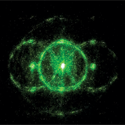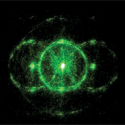Diffraction of a nonexistent beam of light
When a nearly monochromatic wave passes through a spatially modulated medium, a diffracted beam, whose wave vector satisfies the vector sum of the incident wave vector and an integer multiple of the medium’s reciprocal lattice vector, can be observed. This is the familiar Bragg condition that is well known in optics and has also been applied to atom-optics and matter waves.
Now, Solomon Saltiel and collaborators from Australia, Bulgaria, Israel, and Denmark have demonstrated diffraction by a virtual beam of light. Writing in Physical Review Letters, the team observed a type of nonlinear diffraction that has no linear analog. In their experiments, two copolarized but noncollinear beams are incident on a nonlinear medium in which the sign of the second-order nonlinear susceptibility χ2 is spatially modulated. The interaction of the two beams through this nonlinear medium results in a diffraction pattern of the second harmonic of the fundamental wave as if a third nonexistent beam of a frequency of the fundamental beams is incident on the medium too, with a propagation direction which is the bisector of the two real beams. Saltiel et al. present a physical picture in which two beams at the fundamental frequency generate, through the nonlinearity of the medium, three waves at the second harmonic frequency.
Results of this work should be readily applicable to acoustic waves in periodic structures and matter-waves in optical lattices. – Frank Narducci





